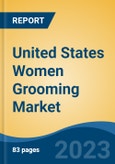Speak directly to the analyst to clarify any post sales queries you may have.
10% Free customizationThis report comes with 10% free customization, enabling you to add data that meets your specific business needs.
Key Market Drivers
Rising Beauty and Self-Care Consciousness
Growing emphasis on self-care and wellness is a major factor propelling the U.S. women grooming market. Grooming has increasingly become an essential part of daily health and well-being routines, moving beyond vanity to embody empowerment and self-confidence. As a result, women are investing more in skincare, hygiene, and beauty products designed to support long-term skin and hair health.The widespread cultural acceptance of self-care has encouraged consistent usage of serums, exfoliators, face masks, and tech-integrated beauty tools. Furthermore, with heightened visibility in professional and social spaces, women across all age groups are motivated to maintain a well-groomed appearance - further driving demand across premium and mass-market segments.
Key Market Challenges
Market Saturation and Intense Competition
A major challenge in the U.S. women grooming market is the high level of saturation and intense competition across nearly all product categories. The influx of established global players, regional brands, and agile indie startups has resulted in product overlap and diluted brand differentiation. Consumers are bombarded with options, ranging from high-end to budget-friendly, making loyalty hard to retain.The ease of market entry - especially in clean and DIY grooming categories - has led to fragmentation, while large corporations leverage massive marketing budgets and influencer partnerships to capture attention. For smaller brands, cutting through this noise and securing shelf space in both physical and digital stores is increasingly difficult, especially with mounting pressure to stand out on values like sustainability, inclusivity, and innovation.
Key Market Trends
Hyper-Personalization and AI-Driven Beauty
The trend toward hyper-personalized grooming is gaining traction, with AI and machine learning technologies enabling tailored product recommendations based on individual skin profiles, lifestyle habits, and preferences. Consumers now expect beauty solutions that go beyond one-size-fits-all approaches.From online diagnostic tools and virtual skin consultations to AR-powered makeup try-ons, brands are integrating tech to enhance customer experience and improve product fit. Companies like Proven Skincare and Function of Beauty are leading the way with algorithm-driven customization, while mainstream brands are increasingly adopting these innovations to boost engagement and conversion rates.
Key Players Profiled in this United States Women Grooming Market Report
- The Procter & Gamble Company
- Unilever United States, Inc.
- Beiersdorf, Inc.
- L’Oréal USA, Inc.
- The Estée Lauder Companies Inc.
- Shiseido Americas Corporation
- Edgewell Personal Care Company
- Coty Inc.
- Johnson & Johnson Consumer Inc.
- Galderma Laboratories, L.P. (Cetaphil)
Report Scope:
In this report, the United States Women Grooming Market has been segmented into the following categories, in addition to the industry trends which have also been detailed below:United States Women Grooming Market, by Product Type:
- Skin Care
- Hair Care
- Fragrances
- Others
United States Women Grooming Market, by Price Range:
- Mass
- Premium
United States Women Grooming Market, by Sales Channel:
- Supermarkets/Hypermarkets
- Specialty Stores
- Multi-Branded Stores
- Online
- Others
United States Women Grooming Market, by Region:
- South
- West
- Midwest
- Northeast
Competitive Landscape
Company Profiles: Detailed analysis of the major companies present in the United States Women Grooming Market.Available Customizations:
With the given market data, the publisher offers customizations according to a company's specific needs. The following customization options are available for the report.Company Information
- Detailed analysis and profiling of additional market players (up to five).
This product will be delivered within 1-3 business days.
Table of Contents
Companies Mentioned
The leading companies profiled in this United States Women Grooming market report include:- The Procter & Gamble Company
- Unilever United States, Inc.
- Beiersdorf, Inc.
- L’Oréal USA, Inc.
- The Estée Lauder Companies Inc.
- Shiseido Americas Corporation
- Edgewell Personal Care Company
- Coty Inc.
- Johnson & Johnson Consumer Inc.
- Galderma Laboratories, L.P. (Cetaphil)
Table Information
| Report Attribute | Details |
|---|---|
| No. of Pages | 81 |
| Published | May 2025 |
| Forecast Period | 2024 - 2030 |
| Estimated Market Value ( USD | $ 55.43 Billion |
| Forecasted Market Value ( USD | $ 82.21 Billion |
| Compound Annual Growth Rate | 6.8% |
| Regions Covered | United States |
| No. of Companies Mentioned | 11 |









